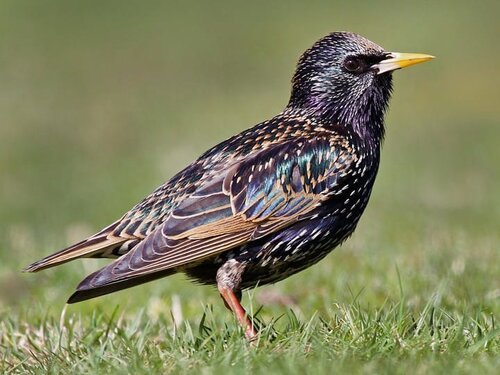Week 2: Advanced
Scroll down to study the birds by sight and sound, and then take the quiz.
Week 2 Birds
Downy Woodpecker, Ring-necked Pheasant, Yellow-headed Blackbird, Red-winged Blackbird, European Starling, House Finch, House Sparrow, Song Sparrow,







Ring-necked pheasant
Bird Code: RNEP
Identify this bird by…
Long-neck and long-tail
Also called “Common Pheasant” in other parts of the world
Tell males and females apart by…
Male - Gaudy; green head, white collar, copper body with black and white spots
Female - Brown overall with black markings, especially on back and wings
Listen for…
Call: The male gives a grating “crow,” which sounds like a rusty, squeaky gate, or a truncated version of a domestic rooster’s crow.
Resources:
DOWNY WOODPECKER
Bird Code: DOWO
Identify this bird by…
White below, upperparts mostly black with a white back and bold white spots in the wings
Head striped black and white
Tell males and females apart by…
Males - Red spot on nape of neck
Females - Red nape bare is absent
Listen for…
Call: An excited string of hoarse, high-pitched notes that descend in pitch toward the end; which lasts about 2 seconds. Excited birds also give a very sharp pik note.
Drum: Rapid strikes given at a steady pace, almost fast enough to blend into a single uninterrupted sound.
Resources:





Yellow-headed blackbird
Bird Code: YHBL
Identify this bird by…
Stout body, large head, conical bill
Tell males and females apart by…
Males - Bright yellow on the head and breast, black body
Females - Less, duller yellow on the head and breast and a brown body
Listen for…
Call: Frequent check calls used in many situations during the breeding season, screams given by alarmed females, growls given by fighting or mating males, and harsh rattles given by males when predators are about.
Song: A few musical notes followed by a screeching buzz, rather like a heavy door swinging on a very rusty metal hinge. Females make a chattering sound that may be considered a song.
Resources:




EUROPEAN STARLING
Bird Code: EUST
Identify this bird by…
Dark/black overall with purplish-green iridescent and yellow bills
In flight their wings are short and pointed, making them look rather like small, four-pointed stars
This bird is not dimorphic…
Meaning the females and males look the same!
Listen for…
Call: European Starlings make all sorts of different noises, and they often imitate other birds. Be careful when you are out in the field to make sure the bird you are hearing isn’t a just a EUST doing some mimicry!
Song: Harsh rattling and high, thin, slurred whistles. Listen especially for the high, squeaky or wheezy notes, and the characteristic “wolf whistle.”
Resources:





HOUSE FINCH
Bird Code: HOFI
Identify this bird by…
Small finch with a conical seed-eating bill
Shallow notched tail
Tell males and females apart by…
Males: Rosy red around the face and upper breast, with streaky brown back, belly, and tail
Females: Not at all red, but plain grayish-brown with thick, blurry streaks and an indistinctly marked face
Interesting note…
Male house finches’ plumage coloration can vary greatly from one another. They can range from yellow to bright red depending on the amount of carotenoid rich foods they eat!
Listen for…
Song: A long, jumbled warbling composed of short notes. The song often ends with an upward or downward slur, and lasts about 3 seconds. The phrasing is similar to an American Robins, but is quicker and more excited
Call: Their characteristic call sounds like the squeak of shoes on the gym floor
Resources:





Red-Winged blackbird
Bird Code: RWBL
Identify this bird by…
Broad-shouldered and stocky bird with a conical beak
Males - red and yellow “shoulder badge” in the breeding season (breeding plumage)
Tell males and females apart by…
Females are crisply streaked and dark brownish overall, paler on the breast and often show a whitish eyebrow
Non-breeding males look scaly and have incomplete shoulder badges
Listen for…
Song: A 1-second “conk-la-ree!” that starts as one note followed by a high pitch and a musical trill. This is a classic sound of wetlands.
Call: Females respond to a singing male with a series of three to five short chit or check notes.
Resources:



HOUSE SPARROW
Bird Code: HOSP
Identify this bird by…
House Sparrows are more chunky and full breasted than other American sparrows and also have a larger, rounded head, shorter tail, and stouter bill
Tell males and females apart by…
Male - Gray crown, white cheeks, a black bib, and a chestnut neck
Female - Plain, buffy-brown overall with dingy gray-brown underparts. Their backs are noticeably striped with buff, brown, and black
Listen for…
Call: The House Sparrow sings a series of nearly identical chirps. Listen to the toneless quality, and the downward inflection of these chirps. They also rattle and chatter.
Resources:



SONG SPARROW
Bird Code: SOSP
Identify this bird by…
· Streaky and brown with thick streaks on a white chest and flanks
· Head is an mix of warm red-brown and slaty gray
This bird is not dimorphic…
Meaning the females and males look the same!
Look for…
Behavior — Male Song Sparrows sing from exposed perches such as small trees
Listen for…
Call: The call note is a warm, rounded “Chimp!”
Song: ~3 very bouncy introductory syllables which are followed by a complex series of notes and trills
Resources:
WEEK 2 WETLAND EXTRAS
Study these birds if you are interested in surveying at Legacy Nature Preserve, the Great Salt Lake Shorelands Preserve, and Utah Lake North Shore.






Sandhill crane
Bird Code: SACR
Identify this bird by…
Large, heavy-body with a long neck and long legs
Gray overall with tan body feathers
Drooping feathers from the back
Red “crown” on face
Broad wings in flight
Look for…
Reddish hue to the feathers on the back; Sandhill Crane preen themselves with mud. These birds live in iron-rich environments, such that the mud gives them a reddish sheen!
Listen for…
Call: Loud, rattling bugle calls, each lasting a couple of seconds and often strung together. They can be heard up to 2.5 miles away and are given on the ground as well as in flight, when the flock may be very high and hard to see.
Other sounds - They also give moans, hisses, gooselike honks, and snoring sounds. Chicks give trills and purrs.
Resources:




HORNED LARK
Bird Code: HOLA
Identify this bird by…
A small bird with sparrow-like shape and color
Males have a bold black mask, yellow on the forehead and throat, and hornlike feathers that can stick up. Females have a similar facial pattern but are paler overall and lack the bold black mask.
In flight, HOLA have long wings and a short square tail. They often forage on the ground and fly low over the ground
Listen for…
Call: a high, piercing one or two-note chip
Song: a complex and tinkling song, with a jumbling sequence of notes that often accelerates and rises in pitch near the end
Resources:



REDHEAD
Bird Code: REDH
Identify this bird by…
Medium-sized diving duck with a steep forehead and round head, and a blue-gray bill with a black tip
Breeding males have a cinnamon head, black chest and gray body.
Females have the same body and head shape, with a medium brown body and pale face.
Tell it apart by…
Similar in coloration to Canvasback, but Redheads have a gray body rather than the white body and back of the Canvasback, and lack the gently sloping forehead of the Canvasback.
Listen for…
Call: males have a wheezy, cat-like waaow call, females give a rough, grating call.
Resources:



MARSH WREN
Bird Code: MAWR
Identify this bird by…
Rusty-brown above with black and white streaks down it back
Underparts are paler, and unstreaked (especially the shoulder)
This bird is not dimorphic…
Meaning the females and males look the same!
Look for…
Behavior — This bird tends to cling to reeds with a foot on two different stalks!
Listen for…
Call: A grating, somewhat buzzy chit. In flight, males and females give a longer series of nasal calls.
Song: A very gurgling, rattling, sound. It sounds both musical and mechanical.
Resources:



NORTHERN SHOVELER
Bird Code: NSHO
Identify this bird by…
Duck with a distinctive, over-sized shovel-shaped bill
Breeding males have green heads, with a pattern of white-red-white on their side.
Breeding male wings in flight have a powder-blue shoulder patch, white stripe, and green secondaries.
Females have distinctive large bill
Listen for…
Call: males gives a wheezy nasal thuk-thUK in display. Females have deep short quacks.
Resources:
